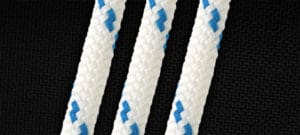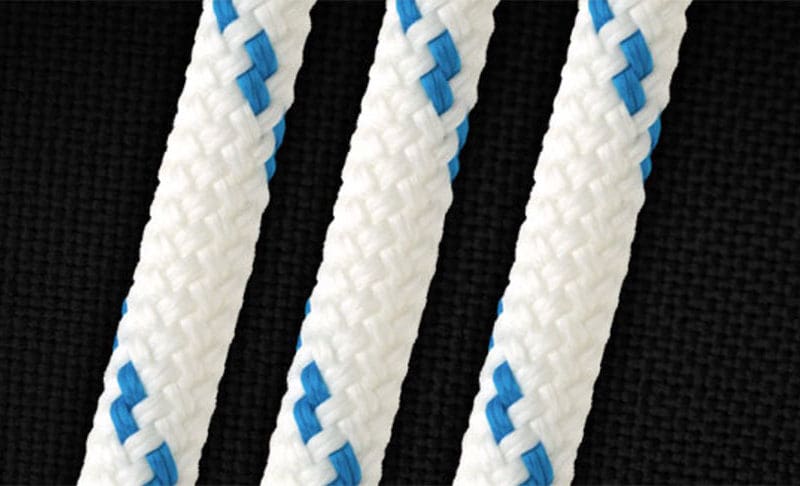
construction.
When considering gear for a voyaging boat, you likely think of a diesel engine or a multifunction display or a bank of batteries. But there’s another type of equipment that most voyaging boats, especially sailboats, can’t operate without: the simple but vital tool of rope. Without rope (line on a sailboat), sailing a boat offshore would be all but impossible. And while rope may seem like a fully developed product in the age of satphones, rope innovation continues. One example of this is Yale Cordage’s ULS Yacht Braid product, a rope for cruising boats that takes advantage of newer materials and new methods of manufacture.
A hundred years ago, the most prevalent type of line found on a boats was made of natural fibers like manila, sisal or hemp. The most frequently used and the strongest was three-strand manila rope, made from the fibers of the Abaca tree grown in the Philippines. Major rope manufactures like the Plymouth Cordage Company in Massachusetts spun massive amounts of manila rope for use on boats and applications ashore.
After WWII, though, natural fiber rope was doomed. Hydrocarbon-based synthetic fibers like nylon and polyester emerged. And these synthetics had big advantages: they’re stronger than natural fibers, and won’t rot or degrade from use like manila, far outlasting the natural fiber king. Another change was the movement away from three-strand twisted rope to braided ropes, usually with an inner core protected by a braided cover.
The improvement to Yale Cordage’s ULS Yacht Braid began with better source material. While Yale builds rope products for a wide variety of applications and industries, it doesn’t manufacture the starting point for rope: thin strands of polyester. It buys these from a supplier. “When we get it,” Skip Yale said, sales manager at Yale, “it looks like dental floss.”
These yarns are twisted together into thicker strands. The strands are then braided on machines that whirl at high speed like caffeine-addled spiders, producing the polyester core of the ULS rope. These cores are then sheathed with an outer braided cover.
According to Yale, the improvement to the source polyester fibers starts with more abrasion resistance due to better a quality polyester fiber and superior coatings.
Improved source yarns are only part of the way Yale has worked up a better product, though. The other improvement, says Yale, is the way the rope is braided. “We’ve taken the braid angle and let it out a bit. Made the core more straight.”
Decreasing the braiding angle might seem counterintuitive — it might seem to make for a weaker rope rather than a stronger one. As Yale explains, however, rope is strongest when the fibers are lying parallel to each other; all being stressed on the same axis. The problem with such an arrangement of strands is that it isn’t much of a rope, there’s little to hold the strands together. That’s why the strands in a three-strand rope like manila are twisted so they stay together as a unit. In a braided rope, this is achieved by the braid. The braiding, while great for getting the strands to act as a unit, does make the strands lie less parallel. They cross each other at angle and this crossing causes abrasion and acts to weaken the rope slightly. In the same way that a knot in a rope — in which the rope can cross itself at sharp angles — weakens it.
So, the ULS (which stands for ultra-low stretch) Yacht Braid from Yale has a core with superior abrasion resistant fibers and has them braided in a way to make them slightly straighter and thus stronger.
In addition to the core, braided ropes also have a cover or sleeve. And for most polyester ropes the cover can provide up to half of the rope’s overall strength. According to Yale, in the ULS Yacht Braid case, the core/cover strength breakdown is 60/40. For those ropes with high tech fiber cores such as Kevlar or Dyneema, on the other hand, the core is doing all the work and the cover’s job is largely to protect the core from issues like abrasion and UV degradation from sunlight.
Rope remains an important tool across a wide variety of pursuits and industries, not just for use on voyaging boats. Some of the sectors that Yale Cordage supplies rope to include commercial marine, entertainment and theatrical, electric utilities, government and defense, inland marine, oil and gas, safety and rescue, mining, heavy lift, mooring, etc.
In his capacity as Yale’s point man for special applications, Skip Yale has worked on some “otherworldly” projects. Yale was involved in the design and testing of the lines for the parachute bridle used by the Perseverance rover when it landed on Mars in February 2021. Another science project for Yale was to make rope for lowering detectors into a series of holes bored in the Antarctic ice at the South Pole. The detectors formed an array called Ice Cube that can sense elusive subatomic particles called neutrinos.
From ice-bound neutrino arrays to halyards, sheets and mooring lines on voyaging vessels, the humble tool of good quality rope remains essential. n

